|
Hawker Hurricane Mk.I
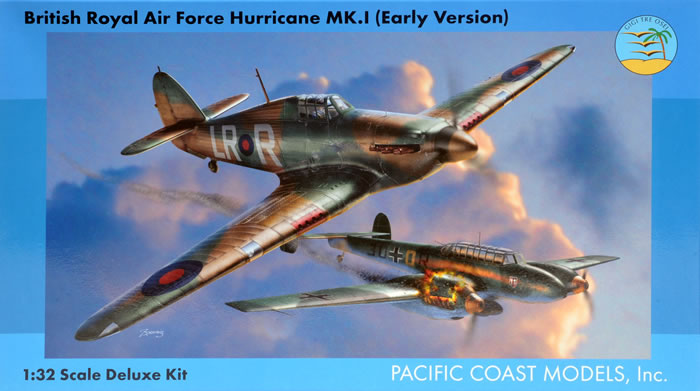
Pacific Coast Models, 1/32 scale
S
u m m a r y |
| Catalogue Number: |
Pacific Coast Models PCM 32010 - Hawker Hurricane Mk.I |
| Scale: |
1/32 |
| Contents and Media: |
71 parts in grey plastic; 12 parts in clear; 24 resin parts; colour photo-etched fret; markings for six aircraft. |
| Price: |
USD$69.95 available online from Pacific Coast Models' website |
| Review Type: |
FirstLook |
| Advantages: |
Accurate outline; high level of detail; subtle surface features including crisply recessed panel lines and convincing fabric texture; pays attention to important design aspects (e.g. shape of early nose); three alternate propellers, different windscreens, wheels, rudders and exhausts; effective use of mutli-media; large and attractive decal sheet with good selection of markings. |
| Disadvantages: |
A little flash to clean up; limited run nature of the kit will require some experience. |
| Conclusion: |
Pacific Coast Models has now delivered the modeller's missing link of WWII fighters - an accurate and well-detailed Hurricane in 1/32 scale. |
Reviewed by Brett Green

HyperScale is proudly supported by Squadron.com
Entering service in 1937, the Hawker Hurricane was Britain's first modern monoplane fighter aircraft.
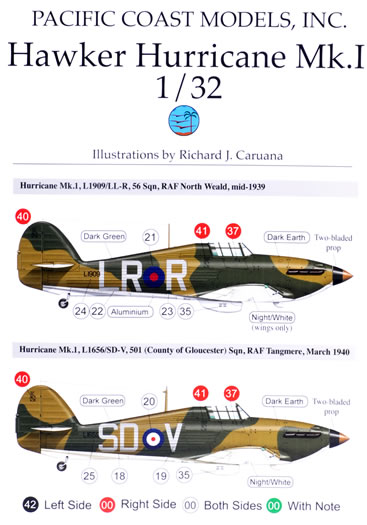 The Hurricane was developed around the new Rolls-Royce Merlin engine by Hawker's chief designer, Sidney Camm. Although there was no order from the British Air Ministry, Hawker nevertheless prepared for production of 1,000 aircraft. This head start greatly accellerated production once the order for 600 Hurricanes was received in June 1936. The Hurricane was developed around the new Rolls-Royce Merlin engine by Hawker's chief designer, Sidney Camm. Although there was no order from the British Air Ministry, Hawker nevertheless prepared for production of 1,000 aircraft. This head start greatly accellerated production once the order for 600 Hurricanes was received in June 1936.
In addition to the fabric mid to rear fuselage, the earliest versions of the Hurricane featured fabric wings, reflecting the earlier production techniques of the Hawker Aircraft Company. These first 600 aircaft were also fitted with a fixed pitch, two-bladed wooden Watts propeller, although these were quickly supplanted by de Havilland and Rotol three-bladed propeller assemblies which permitted pitch adjustment from the cockpit. These improved aircraft also included windscreens with armoured glass. In time, the fabric wings of many of these early Hurricanes were replaced with metal wings.
During the Battle of France, the Messerschmitt Bf 109 E proved itself somewhat superior to these early Hurricanes, especially those fittes with the two-bladed Watts propeller, but the new British fighter had the edge over the prestigious twin-engined Bf 110. Although the Hurricane could absorb an enormous amount of punishment and could out-turn the Bf 109 (and even the Spitfire) it was a slower aircraft. During the Battle of Britain, its main role was to engage Luftwaffe bombers, with Spitfires tackling the more nimble German fighters. Although the fabric wing was largely phased out by this time, there were still examples of this type in use over England in that fateful summer of 1940.
Less glamorous than its legendary stablemate, the Hawker Hurricane was nevertheless a key factor in the RAF's victory in the Battle of Britain.
Modellers have been waiting a very long time for a decent 1/32 scale Hawker Hurrcane. Revell released a late version Hurricane Mk.I (metal wings) in the 1960s that was quite accurate in outline but suffered from the simple cockpit, wheel wells and undercarriage plus the moving parts typical of the era. This was later inadequately modified and released as a Mk.II, but it retained many of the unique Mk.I characteristics.
Remarkably, in the intervening four decades, nobody else has released a Hurricane in this popular scale.
Until now.
Pacific Coast Models' Hurricane Mk.I early version comprises 71 parts in grey plastic, 12 parts in clear, 24 resin parts, a colour photo-etched fret and markings for six aircraft.
The plastic parts have been moulded by Sword of the Czech Republic. The plastic is shiny, and surface detail is excellent - crisply recessed fine panel lines are supplemented by subtle fabric texture on the mid to rear fuselage, the wings and the tail places. Fasteners are depicted by raised circles on the engine cowling and wings. These should look fine under a coat of paint but it would also be a simple matter to sand them down or replace them with small punched circles. The overall impact is restrained and impressive.

Interior detail is just as nice as the outside. The cockpit is built up from plastic, resin and photo-etched parts. The cockpit's surrounding Warren girder-type fuselage interior of high-tensile steel tubes, frames and longerons is nicely depicted. The seat is a resin part with colour photo-etched Sutton Harness and instrument panel. A resin sidewall on the port side features a map case, paired on the starboard side with a side console perched on tubular framing. The "bottomless" cockpit floor with footrails looks good too.
The 24 grey resin parts include wheels, nicely detailed undercarriage bays and two different styles of exhaust - one for the Merlin II engine and one for the Merlin III. The two styles of wheels included are four spoke and five spoke.
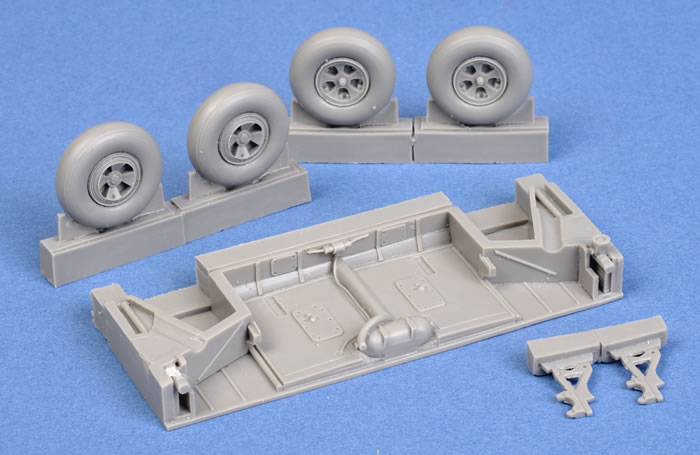
The resin parts are bristling with detail and are appropriately three-dimensional when required.
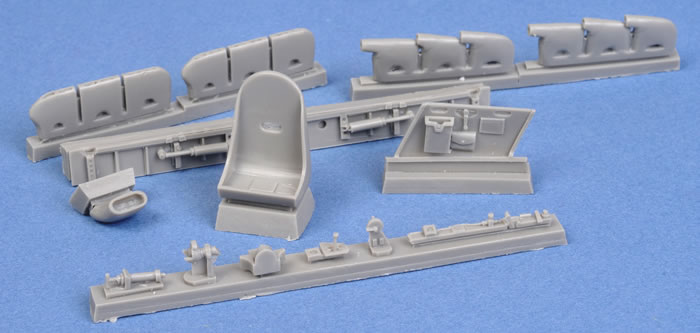
The colour photo-etch fret offers glorious eye-candy for the front office including a beautifully detailed instrument panel, harness straps with printed stitching detail and much more.

The clear parts are very nice - thinly moulded and good looking in shape. Only time and test fitting will tell if the centre sliding section will fit over the spine when the canopy is glued in the open position! Two styles of windscreen are supplied - one with external armour and one without. I particularly like the treatment of the leading edge landing lights, which include clear lenses for the globes and the covers plus photo-etched details. We are also supplied with clear navigation lights for the wing tips and rudder.
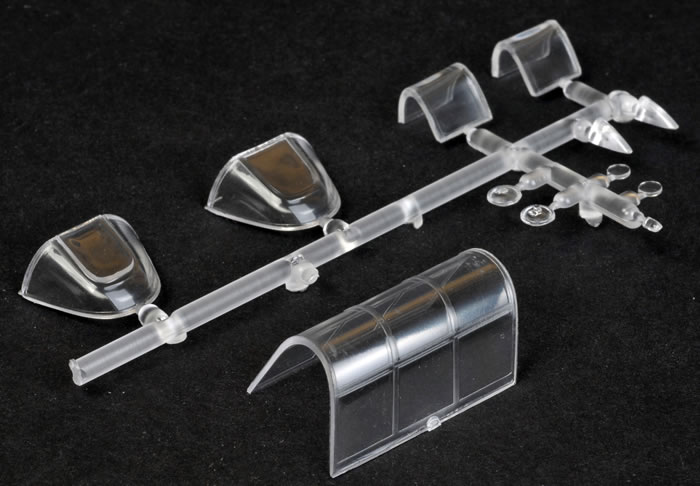
Engineering and parts breakdown looks straightforward. Being a limited run kit there are no locating pins, so take your time with test fitting and alignment before committing to glue. The lower wing is full span, with the upper wing halves supplied separately. All control surfaces are moulded in the neutral position. Flaps are moulded in the closed/up position. The trailing edges of wings and tailplanes look thin. The horizontal tail planes are a butt-fit with no tabs, so reinforcement with a metal pin would be helpful here.
The overall profile and plan form looks accurate. It should be pointed out that this is not a simple scale-up of the Classic Airframes kit, and that the shape of the nose is correct for an early Hurricane Mk.I.
Pacific Coast Models has provided all the parts needed to build any of the early variations from the first two Hurricane production batches. The options include:
-
The choice of Watts Z-38 two-bladed, Rotol RMS-7 three-bladed or de Havilland 5/31 three bladed propeller assemblies. For the Watts prop option, the instructions advise to carve off the chin bulges moulded to the engine cowling too.
-
Different resin exhausts for the Merlin II or Merlin III engines,
-
Armoured or unarmoured windscreens,
-
Optional ventral strake and alternative rudder bases for initial and early aircraft,
-
Both four spoke and five spoke wheels. I understand that the five spoke wheels will apply to most (if not all) of these options.
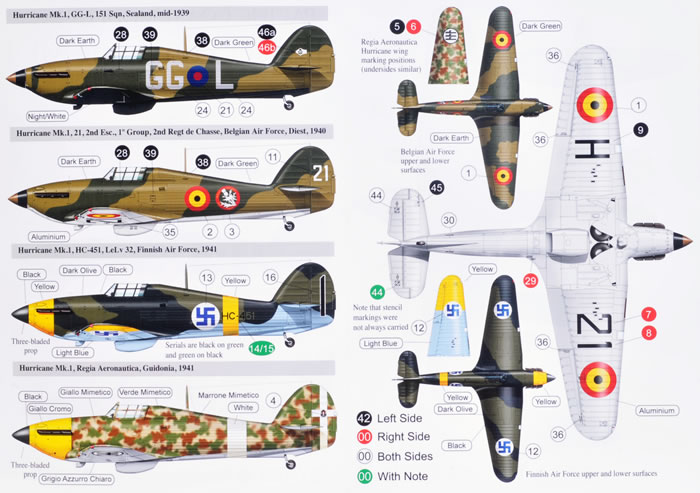
The large colourful decal sheet is printed by Cartograf. Six varied options are offered - three British, one Belgian, one Finnish and one Italian.
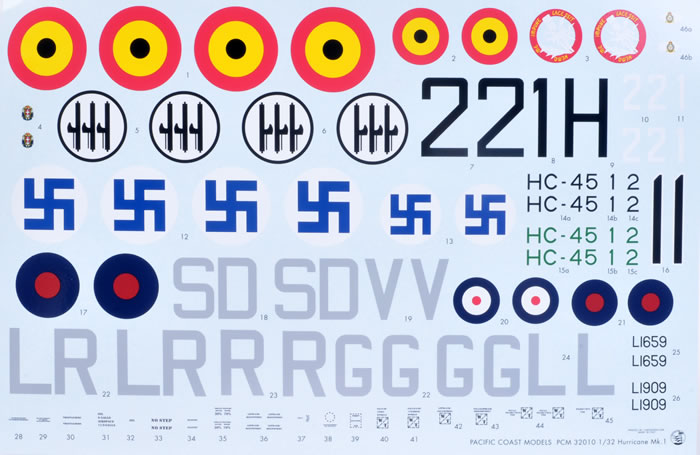
Decals are in perfect register.
Instructions are laid out in a twelve page stapled booklet. Early on, the instructions illustrate the three main variations, labelled A, B and C. Optional parts in the instructions are labelled with these letters. A letter-sized A4 sheet provides colour and marking information.
Pacific Coast Models' 1/32 scale Hurricane Mk.I is well detailed, has attractive surface texture, and appears to be accurate in outline. With its comprehensive resin content supplemented by colour photo-etch, you won't have to spend a cent on after-market improvements, making the ticket price of USD$69.95 sound pretty reasonable.
Due to its limited-run nature, you should ideally have had some experience with short run kits or resin accessories before tackling PCM's Hurricane.
However, if you take your time preparing parts and test fitting, and treat this kit with the respect that any limited run offering deserves, then you should be rewarded with a very attractive and detailed model of this important and interesting Hurricane variant.
Sample kit purchased by reviewer
Review and Images Copyright © 2010 by Brett Green
Page Created 12 January, 2010
Last updated
13 January, 2010
Back to HyperScale Main Page
Back to Reviews Page |
